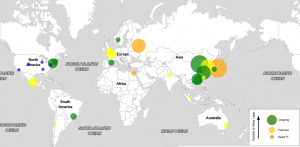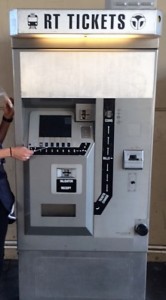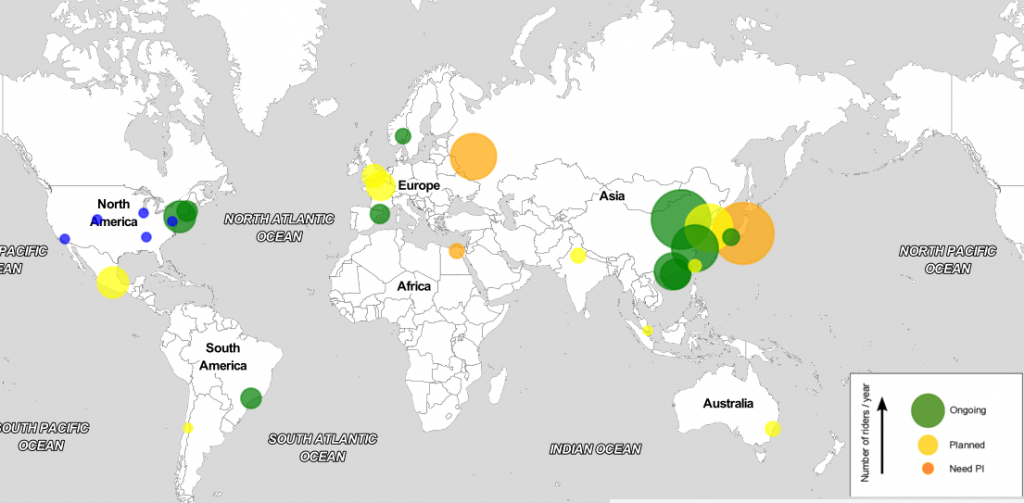One afternoon while making my way through another DNA extraction, I was eavesdropping over the lab benches, per usual, trying to keep my mind occupied. I overheard my project manager and another undergraduate discussing an unusual project. “Do you want to contact the Sacramento authorities to get clearance to swab the light rail, because talking to the city officials is the absolute last thing I want to do” David, the project manager asked cynically. While the idea of blindly cold calling various Sacramento governmental departments is not necessarily my idea of a good time, I could not help but be intrigued by the discussion at hand. In fact, I found myself itching for more details, yearning to find out what the rest of the project entailed.

MetaSUB, Metagenomics & Metadesign of Subways & Urban Biomes, is an international project headed by Christopher Mason out of the Weil Cornell School of Medicine (he has blogged about it on microBEnet here). The project aims to collect metagenomic data from public transportation systems from 43 international cities around the world. MetaSUB was modeled after Mason’s PathoMap project (Afshinnekoo et al. 2015) that gathered metagenomic data from every subway station in New York City to create a “microbial map” of the transit system. The results were surprising. We know less about the DNA we come into contact with than we had anticipated; over 48% of the sequenced DNA did not match any known organisms! Of the microbes they did recognize, traces of Shewanella frigidimarina, a microbe that is typically associated with Antarctic fish, appeared on the walls and floors of the stations. These microbes could have washed up during the flooding from the hurricane, suggesting that microbial DNA can track environmental history, creating a “microbial echo” of the station. This potential history log could enable a deeper understanding of the current environment.
The PathoMap results sparked further curiosity and led to the creation of MetaSUB. This worldwide project needed a Sacramento representative, so I jumped right in. I may have volunteered a little prematurely, not fulling understanding many aspects of the project. I had never worked with or studied metagenomics and our lab had not been involved in extensive metagenomic studies previously. The project had begun almost six months earlier, so in addition to tackling an intimidating learning curve, I was working against time.
I spent the first several weeks trying to piece together the logistics. I was reading through long email threads, reading up on conference call minutes, always feeling a step behind. To add to my sense of under qualification, I quickly realized up that I am, by far, the youngest contributor on the project, as a 4th year undergraduate.
An international conference call would take place on the first Thursday of every month to discuss logistics, to coordinate individual city updates and to encourage contributors to stay on track. Overly nervous during the first phone call, I did not say more than a single word. I only mustered the courage to squeak, “here” during the initial roll call. Each month I contributed more to the conference call, giving updates and asking questions. I learned how to deal with a new level of professionalism in a new research environment. It was an incredible experience to participate–well, mostly listen– to such accomplished and insightful individuals work through the brain storming stages of a project. While absorbing the scale and magnitude of this project, I was struck by the array of accents and modes of communication through which my colleagues interacted. The diversity of language, background, and cultures within these conference calls highlighted the weight and scope of this project.
With such a large intricate, coordinated project, I was anticipating a detailed protocol that I was expected to follow. However, my “cook book” university schooling had not prepared me for the process of experimental design preparation. There is more that goes into this project than just collecting data. MetaSUB brings together many diverse perspectives, to foster a larger scale open forum and to generate the most consistent and effective protocol. Therefore, the project was choreographed into two phases.
Phase 1, June 2015-June 2016, entails designing and coordination of projected plans in all 49 cities. Each lab will run a pilot study to work out any kinks and to ensure that each lab can overcome the potential low biomass yield issue. The pilot study will consist of roughly 30 samples and be discussed at the 2016 MetaSUB conference in Shanghai, China. The conference will bring together a representative from each city to discuss pilot study results and determine the exact protocol that will be followed during data collection. June 21, 2016 is the coordinated international collection day and marks the beginning of phase two. On this exact day, every lab from each of the participating cities will collect samples from their entire public transportation system. Phase 2, from June 21, 2016 through the end of the project, will entail executing the finalized plan and analyzing the data.

Since the pilot study is a scaled down version of the actual study, I wanted to find a way to involve the community. Therefore, I contacted a local high school biology teacher, and she was more than excited to have her students involved in a global science project through involvement with sampling and extraction process. Thus, her class would be divided into teams and each team will swab different high school surfaces and would receive replicate samples of the light rail system. Each student will work through an extraction and quantify the DNA. The replicate with the highest concentration and the top 10 highest concentration high school surface samples will be sent off to New York to be sequenced, processed, and presented at the Shanghai conference. This pilot study plan, involves every student and will help ensure DNA from each site, allowing for a small but interesting comparison between the high school and light rail microbial community.
Public transportation is a distinct environment that brings together a diverse group of people. The surfaces that humans come into contact with are “high traffic exchange platforms” that create a unique space for microbial exchange. This microbe biome is interestingly a unifying factor across all cities and allows for a comparison of an unimaginable range of variables, from temperature to culture. Obtaining written consent from the authorities of the light rail system was a classic bureaucratic struggle; however, I was surprised when they eventually responded with enthusiasm. They were excited about the idea of a “real” science project that might dispel some of the stereotyped germaphobe stories of public spaces. Working in a microbial-enthused lab, I was unaware of the abundance of the commonly held misconceptions of microbes that cause an irrational fear of germs. Exposed to this ignorance, I was only further motivated to reach out to the community and do my part in expelling these myths.
Within the next couple of weeks I will collect the pilot study light rail samples and start to work with the high schoolers. Now that I am a few months in, I feel like I have a much better grasp on the project and am astonished by how much I have learned through the process. I am excited to see how the rest of the project pans out!
